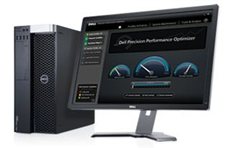I’ve been using workstations for more than ten years, and let me tell you – these are not your ordinary PCs. The hardware is amazing, and these systems are fast.
But what if you could get a little extra performance on the same hardware…for free? Interested? That’s just part of the story….
I was very happy to help develop and now introduce Dell Precision Performance Optimizer, or DPPO, our newest tool for Dell Precision workstations that can help your system achieve its optimum state for the software you use, as well as keeping your system up to date and tell you exactly what your workstation is doing when you want to know.
DPPO is built around three pillars: Automatic Performance Optimization, System Maintenance, and Tracking & Reporting.
 High-end hardware is only part of the workstation experience – world-class software packages demand the upper echelon of performance. Out of the box these are the fastest systems available. But we know applications such as Autodesk Maya, PTC Creo, Dassault SolidWorks, and Adobe Premiere Pro, After Effects, Photoshop, and Media Encoder, don’t always follow a “one size fits all” approach, and as such, tuning or “tweaking” a number of hardware and software parameters can often give benefits directly to the user experience.
High-end hardware is only part of the workstation experience – world-class software packages demand the upper echelon of performance. Out of the box these are the fastest systems available. But we know applications such as Autodesk Maya, PTC Creo, Dassault SolidWorks, and Adobe Premiere Pro, After Effects, Photoshop, and Media Encoder, don’t always follow a “one size fits all” approach, and as such, tuning or “tweaking” a number of hardware and software parameters can often give benefits directly to the user experience.
The beauty of the Automatic Performance Optimization module is that it does this automatically! Once DPPO knows you are using SolidWorks, for example, it will change the system to the optimal configuration without you having to make these changes yourself. You select the profile for the application you are using, and DPPO takes it from there.
You also know that your system will always be up to date. More than just getting updates to the operating system, the System Maintenance module provides you with the latest drivers and firmware for all the hardware components you have – you can even determine when you want updates and for only certain parts of your system.
Here’s a video that explains how DPPO works:
Have you ever wanted to know exactly how your system reacts to how you use it? Information such as how much free memory, processor utilization, and even thermal sensor data is all available over a timeframe that you determine from within the Tracking & Reporting module. You (or your IT department!) can get a fully detailed system report while your workstation is compiling code or rendering frames. DPPO lets you get a glimpse under the hood during the most intensive and important times you are utilizing your workstation.
We are very excited to offer DPPO to our workstation customers and we’d like to hear your feedback – what application profiles would you like to see next? What else would you like DPPO to monitor and report? What kind of performance improvements are you experiencing?
Stay tuned for details on the availability of new profiles and new languages supported soon!